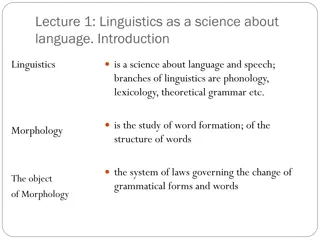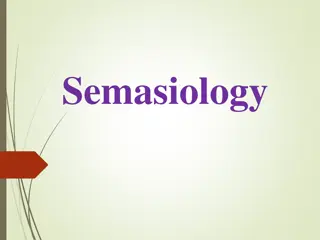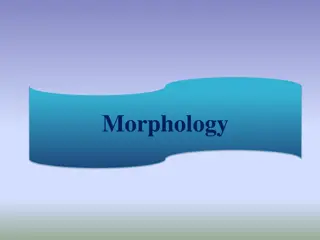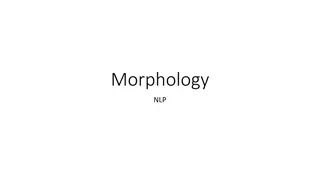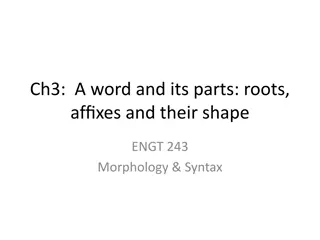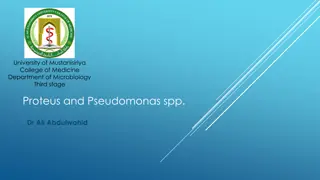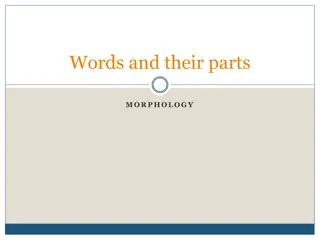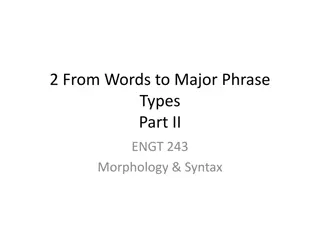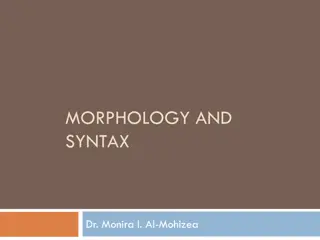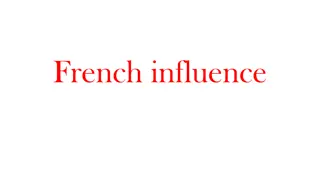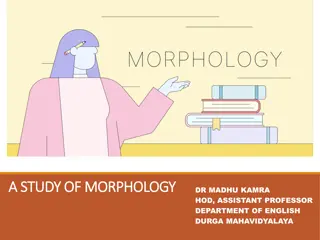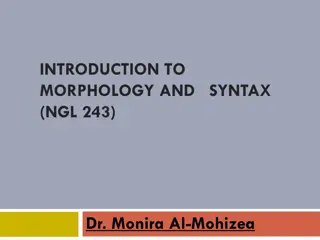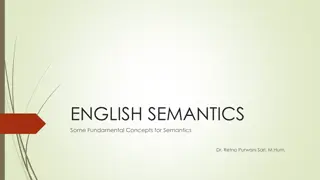Understanding English Morphology: The Study of Words and Meaning
English Morphology delves into the structure of words, exploring morphemes as the building blocks of linguistic meaning. From free morphemes like "certain" to bound morphemes like "-ly," the discipline uncovers how words are constructed and adapted grammatically. By examining the derivational and inflectional branches, linguists unravel the ways in which new words are formed and existing words are modified. The analysis of meaningful units in words, such as "shyness" and "loudness," reveals the intricate relationship between morphology and semantics in language.
Download Presentation

Please find below an Image/Link to download the presentation.
The content on the website is provided AS IS for your information and personal use only. It may not be sold, licensed, or shared on other websites without obtaining consent from the author. Download presentation by click this link. If you encounter any issues during the download, it is possible that the publisher has removed the file from their server.
E N D
Presentation Transcript
English Morphology Dott.ssa Gloria Cappelli
What is a word? Word: not a strightforward notion. The smallest meaningful unit of language is a MORPHEME certain,mean,linguist:free morphemes (they can stand on their own) -ly, -ing, -less: bound morphemes (they can only be used attached to a free morpheme)
What is morphology? The subdiscipline of linguistics which studies the internal structure of words, the rules that govern it, as well as the ways of creating new words.
Morphology (1) Morphology is normally subdivided into two branches: 1.Derivational (or Lexical) Morphology it studies the means by which existing words have been constructed and by which new words might be created. 2. Inflectional Morphology it studies the way words are adapted in different grammatical contexts. (e.g. making a noun plural)
Morphemes Word analysis involves breaking a word into its morphemes. Literally, the word "morpheme" means 'an element in a system of forms.' Linguists define it more precisely as the smallest form which is paired with a particular meaning. We say that each form (i.e. MORPH) plus the meaning linked to it is a single morpheme.
Meaningful units (1) How can we identify which part in a word is meaningful and what meaning it has? SHYNESS shy = nervous and embarrassed about meeting and speaking to otherpeople . a meaningful unit, a morpheme. -ness = ? There is no such a word in English. BUT the fact that there are many words that contain the unit ness makes us think that it might be a morpheme. To verify this, we should find out if it has a meaning, by paraphrasing different words containing - ness , in order to see whether it contributes any meaning to the overall meaning of these words.
Meaningful units (2) shyness = the state or property of being shy loudness = the state or property of being loud sadness = the state or property of being sad happiness = the state or property of being happy - = the state or property of being X NESS it is a morpheme it cannot be subdivided any further into meaningful components The same thing happens for: dream,shy,loud,sad,happy
Types of Words dream shy happy sad loud These words consist of more than one morpheme. These words consist of only one morpheme. MONOMORPHEMIC orPOLYMORPHEMIC or SIMPLEX words v COMPLEX words
Complex Words Clearly morphemes and words are not necessarily the same thing. Words may be composed of one or many morphemes. In fact, most long words in English can be broken down into smaller units. The longest word in English (according to Webster's Unabridged Dictionary) contains 45 letters; it can be broken down into 9 morphemes.
Morphology vs. Etymology (3) If we compare the paraphrases of words containing -tain and ped- , they do not follow the same pattern as was the case with the morphemes - less or -ness . The meaning of these Latin morphemes is not readily traceable. It is unclear, from the point of view of today s English, what the meaning of -tain in these words might be. These words are etymologically complex, BUT they are simplex in today s English Morphology Etymology
Exercise Complex or Simplex words? C S C C S C paper S classroom C trial C sadly C dogs C think - er student un - fair excel(l) - ent ugly post - modern - ist paper class - room try - al sad - ly dog - s thinker student unfair excellent ugly postmodernist
Morphemes vs. Syllables (1) Morphemes should not be confused with syllables. a unit of meaning a unit of sound Sometimes a single morpheme has several syllables. e.g. English speakers would probably consider the word "hurricane" as a single morpheme. (derived from Spanish, which in turn drew the word from Taino, an Arawak language from the Caribbean) At other times a morpheme will use less than one syllable. cats has two morphemes in one syllable: 'feline' + 'plural'. cats has three morphemes in a single syllable: 'feline' + 'plural' + 'belonging to'.
Characteristics of Morphemes Morphemes have four defining characteristics: 1.They cannot be subdivided. 2.They add meaning to a word. 3.They can appear in many differentwords. 4.They can have any number of syllables.
1.One form, two (or more) meanings Two different meanings can be expressed using the same arrangement of sounds. Since there are clearly two different and unrelated meanings, we would want to say that there are two different morphemes. The case of in- : in- 'not' in words like incapable, insufficient in- 'into, within', as in invade, include These similarities are just accidental and typically the origins of the two morphemes are completely unrelated.
2.Two (or more) forms, one meaning When two different forms have the same meaning, they could be different morphemes, or they might be a single morpheme. Two forms, one meaning = two morphemes There are two situations in which two forms have the same meaning, but they are different morphemes. 1. The forms are usually rather different from one another. andr 'man, male' as in android vir 'man, male' as in virile Both morphemes mean the same thing, but they are very different in form. They have completely different origins, and we want to think of them as different morphemes.
Allomorphs The same morpheme can be realised in different ways. The different realisations of the same morpheme are called ALLOMORPHS. This is usually the result of phonology interacting with morphology. in-elegant il-legal allomorphs im-polite ir-regular in- , im- , il- , ir- Consider the different realisations of the morpheme {plural}: car > cars (Regular form) mouse > mice vowel change tooth > teeth vowel change child > children vowel change + suffix -ren sheep > sheep zero morph
Bases disagree construction cheerful recreation agree construct cheer create disagreeme constructional cheerfulnes recreational Words in (1) give the bases for the derivatives in (2), which in turn contain the bases for the derivatives in (3). However, bases in (1) differ from bases in (2). Bases in (1) do not contain any further morphemes, therefore they cannot be analysed into constituent morphemes, unlike bases in (2). Bases in (1) are simplex and they are called ROOTS. Bases in (2) are complex: disagree dis-, agree 2 constituent morphemes recreation re-, create, -ion 3 constituent morphemes
Roots, Bases and Stems ROOT:The morpheme which lies at the core of a complex word form. Words may have multiple roots. BASE:Any form (morpheme or word) which enters a word- formation process which yields a more complex form. The term "stem" is reserved for inflectional processes . STEM:A form without any inflectional endings. WINNERS: "winner" is the stem. Also, {WIN} is the root. WINNER: {WIN} is the root and "win" is (also) the base. PLAYFUL: {PLAY} is the root of the word and "play" is its base. PLAYFULNESS: the root is still {PLAY}, but the base is "playful". FAIRPLAY: two roots, {FAIR} and {PLAY}.
Types of morphemes (3) management motherhood cheerful settlement unhappy dislike mispronounce malnutrition Bound morphemes, such as un- and -ment , which appear only attached to other, usually free, morphemes are termed AFFIXES. Affixes attached before the base are PREFIXES. Affixes attached after the base are SUFFIXES. Affixes can differ in their position with respect to their bases. Cases in which the affix is inserted into the base INFIXES. In English, infixation generally only happens with swear words such as fan-fucking-tastic or abso- bloody-lutely .
Types of morphemes (4) Irregular words do not obey the general rules for forming plurals or past tenses. However they are still considered to be made up of the same number of morphemes as if they were regular. sheep > sheep zero morph mouse > mice vowel alternation mice contains two morphemes as it is made up of the root mouse and the idea of plurality, i.e. the morpheme morethan one . give > gave vowel alternation gave also contains two morphemes as it is made up of the root give and the idea of past tense.
Morphological Analysis (1) BLENDER It consists of 2 morphemes: blend and -er . blend is the root and the base to which the suffix -er is attached. GLOBALISATION It contains 4 morphemes. globe is the root and -al , -ise and -ation are t suffixes. Each suffix has been attached successively to that part of the word after which it appears: -al appears after globe , which is its root and base, -ise appears after global , which is its base, -ation appears after globalise , which is its base. Spelling changes may occur if affixes are attached to a base. !
Morphological Analysis (2) UNFEARFUL It consists of 3 morphemes. fear is the root and base to which the suffix -ful is attached. un- is the prefix attached to the base fearful . unfearful fearful un fear ful Morphological Analysis it shows what morphemes a word consists of, it describes these morphemes in terms of their type, and it also identifies the order in which they are combined
Exercise Morphological analysis: For the following words identify the number of morphemes, all roots, bases and affixes. premodernism 3 morphemes: premodernism uncivilised 4 morphemes: uncivilised demilitarisation 4 morphemes: demilitarisation historicity 3 morphemes: historicity minimalists 4 morphemes: minimalists recreation 3 morphemes: recreation removable 3 morphemes: removable exceptionally 4 morphemes: exceptionally
Morphological processes BAKES BAKED They are not two different words, but two different forms of the same word, i.e. bake. They are grammatically fully specified forms of an abstract unit, i.e. bake. WORD-FORMS LEXEME (or grammatical words) The different grammatically specified forms of a given lexeme (e.g. bakes, baking, baked) A word as an abstract unit in the vocabulary of a language (e.g. bake) BAKER vs. BAKES/BAKED It is not a word-form of the lexeme bake, but it is a different lexeme. As a lexeme, it manifests itself in different word-forms, e.g. baker (sing.), bakers (pl.), baker s(possessive).
Morphological processes (3) DERIVATION INFLECTION The grammatical categories. Affixes used to encode grammatical information and thus to create different word- forms of the same lexeme. -s in bakes -ed in baked morphological expression information of The morphological process for the creation of a new lexeme by affixation. Affixes used for the creation of new lexemes, i.e. new stands for different in meaning from the base . -er in baker -ery in bakery and Such affixes are called derivational. Such affixes are called inflectional.
Inflectional Affixes The inventory of English inflectional affixes is quite small. See Ballard, The Frameworks of English, Chapter 4
Derivational Affixes See Ballard, The Frameworks of English, Chapter 3.
Recap on Affixes Recap on Affixes DERIVATIONAL Affixes they encode grammatical information and are used to create word-forms they are always suffixes they have consistently the same grammatical function of the word they attach to they attach to every word of a given class they never change the word- class of the base. they create new lexemes they can be suffixes or prefixes they can have different meanings in different words they attach to certain words of a given class they can change the word- class of the base.
Word Formation See Ballard, The Frameworks of English, Chapter 3.
Exercise Identify the type of word-formation process by which the following words have been created. ad edit Chaplinesque deforestation phone blackboard NASA YMCA happily flu oxen goes motel BLENDING motorway + hotel BACK CLIPPING advertisement BACKFORMATION editor DERIVATION Suffix -esque (Adj) DERIVATION Prefix -de / Suffix -ation FRONT CLIPPING telephone COMPOUNDING Adj + N ABBREVIATION (Acronym) ABBREVIATON (Initialism) DERIVATION Suffix -ly (Adv) MIXED CLIPPING influenza INFLECTION irreg. plural of ox INFLECTION 3rd person sing. Present
Exercise Identify the type of word-formation process by which the following words have slow slowness memory memorise recreation recreational glory glorify drink drinkable deliver delivery rich enrich Determine determination love loving power powerful happy happily Adj N N V N Adj N V V Adj V N Adj V V N V Adj N Adj Adj Adv
Recap 1 Morphology Morpheme = form + meaning bound vs. free morphemes Bases (simplex or complex), roots, affixes Affixes prefixes, suffixes, infixes Types of morphemes zero morph, vowel change Morphological analysis Morphological processes derivation vs. inflection Derivational vs. inflectional affixes Lexemes vs. word-forms (allomorphs)
Recap 2 Inheritance Borrowing domination, need, prestige Root creation motivated, ex nihilo Word Formation New Root formation Modification Folk Etymology Functional Shift conversion Abbreviation initialisms, acronyms, clipping, back formation Generation Semantic change Derivation affixation Compounding endocentric,exocentric, appositional Blending Generalisation Specialisation Metaphor Shift
Exercise From the following list of words, identify words with inflectional and derivational morphology. I free m. free m. D free m. free m. free m. free m. I free m. I free m. links Indo-European ordering geese such flew these within John s beloved thought uncomfortable I D I I free m. I I D I D I D elements gain and unkind as some case example features great had speech
Exercise Analyse the following words: 3 ms: mismatched / D - I 3 ms: telebanking / D - D 2 ms: rose + water / Compound 3 ms: postmastership / D - D 3 ms: beloved / D - D 2 ms: sing + Past Tense / I 3 ms: Indo + European / Comp. D 2 ms: sheep + plural / I 3 ms: inputs / D - I 3 ms: economics / D - D 4 ms: academically / D - D D 2 ms: clever + comparative -er / I mismatched telebanking rosewater postmastership beloved sang Indo-European (many) sheep inputs economics academically cleverer
Exercise 1. treat (root) + mis- (derivational) + -ment (derivational) 2. act (root) + -ive (derivational) + -ate (derivational) + -ion (derivational) + dis- (derivational) 1.mistreatment 2. disactivation 3.psych- or psyche (root) + -ology (derivational) 4.terror (root) + -ize (derivational) + PAST (inflectional) if the word is a verb form OR terrorized = terror (root) + -ize (derivational) + -ed (derivational) if the word is an adjective 3. psychology 4. terrorized
Exercise When a compound has more than 2 roots, two of them might form a compound which then combines with a third root to form another compound. drop-in center drop-in + center
Exercise Identify the relations between the elements of the following compounds: dual carriageway dual + carriageway disk operating system Dutch elm desease fair-weather friend fine-tooth comb local area network optical character recognition optical + [c. + r.] repetitive strain injury disk + [operating + system] [Dutch + Elm] + desease fair-weather + friend fine-tooth + comb local + [area + network] [r. + s.] + injury
Exercise Aanalyse the following lexical items: filling stations Root(s): fill, station Affixe(s): -ing, -s Morphological process(es): I (pres. part.) + D (compound) + I (pl) ([[fill+ing] + station] + s) Word-class: Noun
Exercise Aanalyse the following lexical items: radio-controlled Root(s): radio, control Affixe(s): -ed Morphological process(es): D (compound) + I (past part.) ([radio + control] + (l)ed) Word- class: Adj
Exercise Aanalyse the following lexical items: absent-minded Root(s): absent, mind Affixe(s): -ed Morphological process(es): D (compound) + D (-ed) ([absent + mind] + ed) Word-class: Adj
Exercise Aanalyse the following lexical items: radio-controlled Root(s): radio, control Affixe(s): -ed Morphological process(es): D (compound) + I (past part.) ([radio + control] + (l)ed) Word- class: Adj
Exercise Which part is the combining form (part of a neo- classical compound)? meritocracy meritocracy ( rule ) pesticide pesticide ( killing ) neorosurgery neurosurgery ( nerve ) anglophile anglophile ( fondof ) technophobia technophobia ( fear ) television television ( distant )
Exercise Which one is the semantic head in the following compounds? Pinhead the head of a pin Pinhole a small hole made with or as if with a pin Pin money money for incidental expenses Pinprick a slight puncture made by or as if by a pin
Exercise Which one is the meaning relation between the components in the following compounds? bookworm One who spends much time reading or studying. brainbox a clever person egghead an intellectual, a highbrow mastermind A highly intelligent person, especially one who plans and directs a complex or difficult project
Identify the inflectional morphemes The place fascinated us, as it should have. For this was the kitchen midden of all the civilization we knew. It gave us the most tantalizing glimpses into our neighbors' lives and our own; it provided an aesthetic distance from which to know ourselves. The town dump was our poetry and our history.We took it home with us by the wagonload, bringing back into town the things the town had used and thrown away. Some little part of what we gathered, mainly bottles, we managed to bring back to usefulness, but most of our gleanings we left lying around barn or attic or cellar until in some renewed fury of spring cleanup our families carted them off to the dump again, to be rescued and briefly treasured by some other boy. Occasionally something we really valued with a passion was snatched from us in horror and returned at once.That happened to the mounted head of a white mountain goat, somebody's trophy from old times and the far Rocky Mountains, that I brought home one day. My mother took one look and discovered that his beard was full of moths. I remember that goat; I regret him yet. Poetry is seldom useful, but always memorable. If I were a sociologist anxious to study in detail the life of any community I would go very early to its refuse piles. For a community may be as well judged by what it throws away - what it has to throw away and what it chooses to - as by any other evidence. For whole civilizations we sometimes have no more of the poetry and little more of the history than this (from Wolf Willow 1955: 35-36).
Additional Readings The Cambridge Encyclopedia of the English Language, Chapter 14, p. 198-205.
Mandatory Readings Introducing English Language, Sections A2, C2. The Frameworks of English, Chapters 3 and 4.
Possible questions Analyse the following words in terms of base, affixes, morphological process(es), word category Identify bound and free morphemes Identify the morphological process at work



